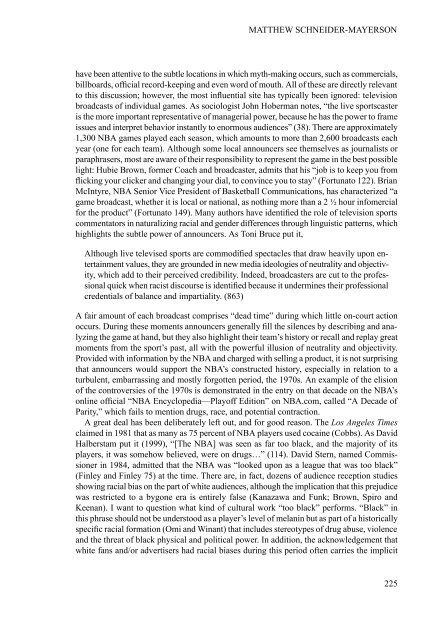Download - University of Minnesota
Download - University of Minnesota
Download - University of Minnesota
You also want an ePaper? Increase the reach of your titles
YUMPU automatically turns print PDFs into web optimized ePapers that Google loves.
MATTHEW SCHNEIDER-MAYERSON<br />
have been attentive to the subtle locations in which myth-making occurs, such as commercials,<br />
billboards, <strong>of</strong>ficial record-keeping and even word <strong>of</strong> mouth. All <strong>of</strong> these are directly relevant<br />
to this discussion; however, the most influential site has typically been ignored: television<br />
broadcasts <strong>of</strong> individual games. As sociologist John Hoberman notes, “the live sportscaster<br />
is the more important representative <strong>of</strong> managerial power, because he has the power to frame<br />
issues and interpret behavior instantly to enormous audiences” (38). There are approximately<br />
1,300 NBA games played each season, which amounts to more than 2,600 broadcasts each<br />
year (one for each team). Although some local announcers see themselves as journalists or<br />
paraphrasers, most are aware <strong>of</strong> their responsibility to represent the game in the best possible<br />
light: Hubie Brown, former Coach and broadcaster, admits that his “job is to keep you from<br />
flicking your clicker and changing your dial, to convince you to stay” (Fortunato 122). Brian<br />
McIntyre, NBA Senior Vice President <strong>of</strong> Basketball Communications, has characterized “a<br />
game broadcast, whether it is local or national, as nothing more than a 2 ½ hour infomercial<br />
for the product” (Fortunato 149). Many authors have identified the role <strong>of</strong> television sports<br />
commentators in naturalizing racial and gender differences through linguistic patterns, which<br />
highlights the subtle power <strong>of</strong> announcers. As Toni Bruce put it,<br />
Although live televised sports are commodified spectacles that draw heavily upon entertainment<br />
values, they are grounded in new media ideologies <strong>of</strong> neutrality and objectivity,<br />
which add to their perceived credibility. Indeed, broadcasters are cut to the pr<strong>of</strong>essional<br />
quick when racist discourse is identified because it undermines their pr<strong>of</strong>essional<br />
credentials <strong>of</strong> balance and impartiality. (863)<br />
A fair amount <strong>of</strong> each broadcast comprises “dead time” during which little on-court action<br />
occurs. During these moments announcers generally fill the silences by describing and analyzing<br />
the game at hand, but they also highlight their team’s history or recall and replay great<br />
moments from the sport’s past, all with the powerful illusion <strong>of</strong> neutrality and objectivity.<br />
Provided with information by the NBA and charged with selling a product, it is not surprising<br />
that announcers would support the NBA’s constructed history, especially in relation to a<br />
turbulent, embarrassing and mostly forgotten period, the 1970s. An example <strong>of</strong> the elision<br />
<strong>of</strong> the controversies <strong>of</strong> the 1970s is demonstrated in the entry on that decade on the NBA’s<br />
online <strong>of</strong>ficial “NBA Encyclopedia—Play<strong>of</strong>f Edition” on NBA.com, called “A Decade <strong>of</strong><br />
Parity,” which fails to mention drugs, race, and potential contraction.<br />
A great deal has been deliberately left out, and for good reason. The Los Angeles Times<br />
claimed in 1981 that as many as 75 percent <strong>of</strong> NBA players used cocaine (Cobbs). As David<br />
Halberstam put it (1999), “[The NBA] was seen as far too black, and the majority <strong>of</strong> its<br />
players, it was somehow believed, were on drugs…” (114). David Stern, named Commissioner<br />
in 1984, admitted that the NBA was “looked upon as a league that was too black”<br />
(Finley and Finley 75) at the time. There are, in fact, dozens <strong>of</strong> audience reception studies<br />
showing racial bias on the part <strong>of</strong> white audiences, although the implication that this prejudice<br />
was restricted to a bygone era is entirely false (Kanazawa and Funk; Brown, Spiro and<br />
Keenan). I want to question what kind <strong>of</strong> cultural work “too black” performs. “Black” in<br />
this phrase should not be understood as a player’s level <strong>of</strong> melanin but as part <strong>of</strong> a historically<br />
specific racial formation (Omi and Winant) that includes stereotypes <strong>of</strong> drug abuse, violence<br />
and the threat <strong>of</strong> black physical and political power. In addition, the acknowledgement that<br />
white fans and/or advertisers had racial biases during this period <strong>of</strong>ten carries the implicit<br />
225

















